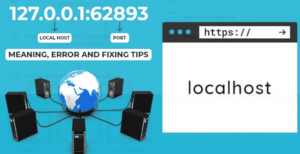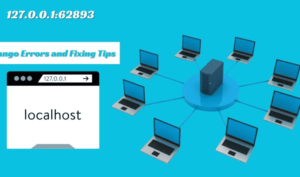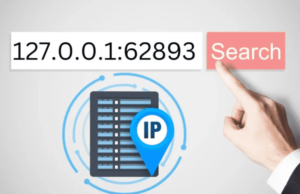Introduction:
127.0.0.1 represents the loopback address (also known as “localhost”). It’s a unique-purpose IP address that allows a device to communicate with itself inside a local system. When information is sent to 127.0.0.1 it’s routed back to the same device. Developers often use this address with for testing and diagnostics.
The port number 62893 accompanies the loopback address. Ports help identify specific methods or services running on a host. In this situation port 62893 directs facts to a specific application or service at the loopback address.
Understanding this combination is essential for network configuration software development and troubleshooting. Developers use it for local testing before deploying programs.
Why is 127.0.0.1:62893 Important?

- Software Testing: Developers use it to check web servers databases and different networked applications locally. Debugging and fine-tuning appear in a controlled environment before deployment.
- Network Configuration: Understanding 127.0.0.1:62893 is crucial for configuring network services and ensuring smooth communication within the system.
- Troubleshooting: It’s an essential tool for diagnosing issues without affecting other machines on the network.
How 127.0.0.1:62893 Works:
Let’s demystify the inner workings of 127.0.0.1:62893.
The Magic Behind 127.0.0.1:62893
- IP Address (127.0.0.1):
-
- 127.0.0.1 also known as the loopback address is reserved for local communication within a device.
- When you send data to this address it’s routed back to your own machine.
- Developers use it for testing and debugging networked applications without involving external servers.
-
Port Number (62893):
-
- Ports allow different services or processes to communicate on a single device.
- 62893 specifies a specific service/application running on your machine.
- Think of it as a door through which data enters or exits.
Practical Use Cases:
- Local Testing: Developers use 127.0.0.1:62893 to test web servers APIs and databases locally.
- Isolated Development: It prevents accidental interactions with external systems during testing.
- Efficient Troubleshooting: Debugging becomes faster when you focus on the local setup.
How can I use 127.0.0.1:62893 for testing?

To use 127.0.0.1:62893 for testing follow these steps:
-
Set Up Your Local Environment:
- Ensure you have the necessary software installed (e.g. web servers databases or other services).
- Configure your application to listen on the specified port (62893 in this case).
-
Testing Scenarios:
- Web Applications: If you’re testing a web application access it via http://127.0.0.1:62893 in your browser.
- API Testing: Use tools like curl or Postman to send requests to http://127.0.0.1:62893.
- Database Connections: Configure your database client to connect to 127.0.0.1:62893.
-
Debugging and Troubleshooting:
- Inspect logs and monitor network traffic to identify issues.
- Test different scenarios (e.g. edge cases error handling) using this local address.
Benefits of 127.0.0.1:62893
- Local Testing Environment:
- 127.0.0.1:62893 provides a controlled environment for testing applications locally.
- Developers can simulate networked interactions without external dependencies.
- It’s essential for debugging and ensuring software works seamlessly before deployment.
- Isolated Development:
- By using 127.0.0.1:62893 developers avoid affecting external systems during testing.
- It prevents accidental data corruption or security risks.
- Efficient Troubleshooting:
- When issues arise developers can focus on the local setup.
- Debugging becomes faster and more effective.
Is It Safe To Expose Port 62893 Publicly?
Exposing port 62893 publicly is generally no safe because of several reasons. While the port itself may not be inherently malicious it’s recommended to keep it closed on publicly accessible machines unless absolutely important. Security risks associated with exposing this port include vulnerabilities in the service using it (such as Memcached) that might be exploited by hackers to breach your system’s security. If you are unsure about whether or not to reveal a port err at the side of warning and restrict public get right of entry to to simplest essential services.
How can I check if port 62893 is open?

To check if port 62893 is open you can follow these steps:
-
Using Command Prompt (Windows):
-
- Open Command Prompt.
- Type the command: netstat -an.
- Look for the port number 62893 in the output.
- Check the status column to see if it’s listed as listening.
- If necessary troubleshoot any issues.
-
Online Port Checker:
-
- Visit the Port Checker website.
- By default it uses your device’s IP address.
- Enter 62893 or any custom port number to check.
- It will verify if the port is open or closed.
What if the port 62893 is closed?
If the port is closed here are some steps you can take to troubleshoot:
-
Check Firewall Rules:
- Verify that your firewall allows traffic on port 62893.
- Add an inbound rule to allow connections to this port if needed.
-
Check Service Status:
- Ensure the service or application using port 62893 is running.
- Restart the service if necessary.
-
Network Configuration:
- Confirm that your network settings are correct.
- Restart your network adapter or router.
Conclusion with a Question
In conclusion paragraph we’ll emphasize the significance of 127.0.0.1:62893 and leave readers thinking about: “How has this humble loopback address converted the way we build and troubleshoot networks?”




